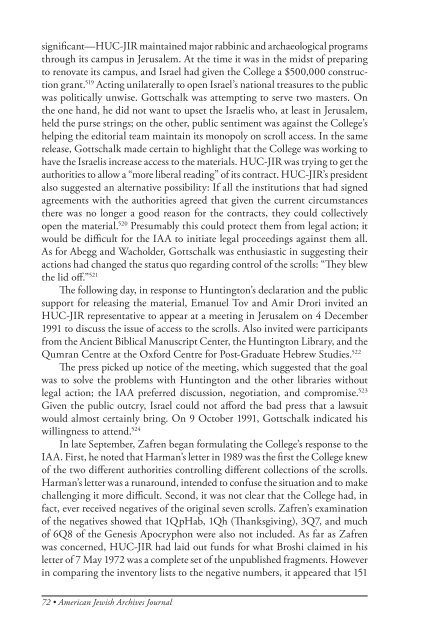The American Jewish Archives Journal, Volume LXI 2009, Number 1
The American Jewish Archives Journal, Volume LXI 2009, Number 1
The American Jewish Archives Journal, Volume LXI 2009, Number 1
You also want an ePaper? Increase the reach of your titles
YUMPU automatically turns print PDFs into web optimized ePapers that Google loves.
significant—HUC-JIR maintained major rabbinic and archaeological programs<br />
through its campus in Jerusalem. At the time it was in the midst of preparing<br />
to renovate its campus, and Israel had given the College a $500,000 construction<br />
grant. 519 Acting unilaterally to open Israel’s national treasures to the public<br />
was politically unwise. Gottschalk was attempting to serve two masters. On<br />
the one hand, he did not want to upset the Israelis who, at least in Jerusalem,<br />
held the purse strings; on the other, public sentiment was against the College’s<br />
helping the editorial team maintain its monopoly on scroll access. In the same<br />
release, Gottschalk made certain to highlight that the College was working to<br />
have the Israelis increase access to the materials. HUC-JIR was trying to get the<br />
authorities to allow a “more liberal reading” of its contract. HUC-JIR’s president<br />
also suggested an alternative possibility: If all the institutions that had signed<br />
agreements with the authorities agreed that given the current circumstances<br />
there was no longer a good reason for the contracts, they could collectively<br />
open the material. 520 Presumably this could protect them from legal action; it<br />
would be difficult for the IAA to initiate legal proceedings against them all.<br />
As for Abegg and Wacholder, Gottschalk was enthusiastic in suggesting their<br />
actions had changed the status quo regarding control of the scrolls: “<strong>The</strong>y blew<br />
the lid off.” 521<br />
<strong>The</strong> following day, in response to Huntington’s declaration and the public<br />
support for releasing the material, Emanuel Tov and Amir Drori invited an<br />
HUC-JIR representative to appear at a meeting in Jerusalem on 4 December<br />
1991 to discuss the issue of access to the scrolls. Also invited were participants<br />
from the Ancient Biblical Manuscript Center, the Huntington Library, and the<br />
Qumran Centre at the Oxford Centre for Post-Graduate Hebrew Studies. 522<br />
<strong>The</strong> press picked up notice of the meeting, which suggested that the goal<br />
was to solve the problems with Huntington and the other libraries without<br />
legal action; the IAA preferred discussion, negotiation, and compromise. 523<br />
Given the public outcry, Israel could not afford the bad press that a lawsuit<br />
would almost certainly bring. On 9 October 1991, Gottschalk indicated his<br />
willingness to attend. 524<br />
In late September, Zafren began formulating the College’s response to the<br />
IAA. First, he noted that Harman’s letter in 1989 was the first the College knew<br />
of the two different authorities controlling different collections of the scrolls.<br />
Harman’s letter was a runaround, intended to confuse the situation and to make<br />
challenging it more difficult. Second, it was not clear that the College had, in<br />
fact, ever received negatives of the original seven scrolls. Zafren’s examination<br />
of the negatives showed that 1QpHab, 1Qh (Thanksgiving), 3Q7, and much<br />
of 6Q8 of the Genesis Apocryphon were also not included. As far as Zafren<br />
was concerned, HUC-JIR had laid out funds for what Broshi claimed in his<br />
letter of 7 May 1972 was a complete set of the unpublished fragments. However<br />
in comparing the inventory lists to the negative numbers, it appeared that 151<br />
72 • <strong>American</strong> <strong>Jewish</strong> <strong>Archives</strong> <strong>Journal</strong>

















